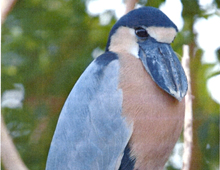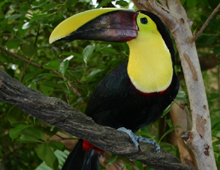Jungle Junction

Boat-billed heron, Cochlearius cochlearius
Long thought to belong to a family all its own, this unique-looking, rather nocturnal bird has been reclassified as a member of the heron family. Dwelling in mangrove swamps from Mexico down to Peru and Brazil, it uses its strange beak to advantage, consuming a broad range of small animals. It thrives and breeds well in captivity, including the DWA.
LEARN MORE
Northern helmeted curassow, Pauxi pauxi
This bird was once extremely rare in captivity, but there are now more than 100 in collections around the world, almost all captive bred. This population is important as this species is endangered, with a wild population of less than 3,000 in the mountains of Colombia and Venezuela. Several have recently hatched at the DWA. The bizarre blue “helmet” is actually part of the skull.
LEARN MORE
Swainson’s toucan, Ramphastos swainsonii
While this bird is still considered fairly common, deforestation is reducing its habitat throughout its range, from Honduras to Ecuador. A particularly noisy toucan, its puppy-like yelps are heard all day in the DWA rainforest. This is another toucan targeted for breeding by the American Zoo community and nearly 40 are distributed among 20 participating collections. The DWA has been one of the few places to so far breed it in captivity.
LEARN MORE
Yellow-crowned night heron, Nyctanassa violacea
Specializing in crayfish, crabs, and other crustaceans, this small heron has gourmet tastes. Once considered a rather tropical bird, it has expanded its North American range in recent years to the north and west. It is also found throughout Central and South America. It has nested repeatedly in this exhibit, performing courtship displays and raising chicks.
LEARN MORE
Giant anteater, Myrmecophaga tridactyla
This enormous relative of sloths and armadillos is found all the way from Honduras to Argentina, but has gone extinct in several parts of this range, and is considered vulnerable to extinction everywhere. More than 250 are maintained in more than 100 zoos around the world, where they breed frequently. True to its name, it rips apart the nests of ants and termites with its powerful claws, then gathers them into its toothless jaws with its long, muscular tongue. In zoos it is fed protein-rich diets prepared in blenders.
LEARN MORE

